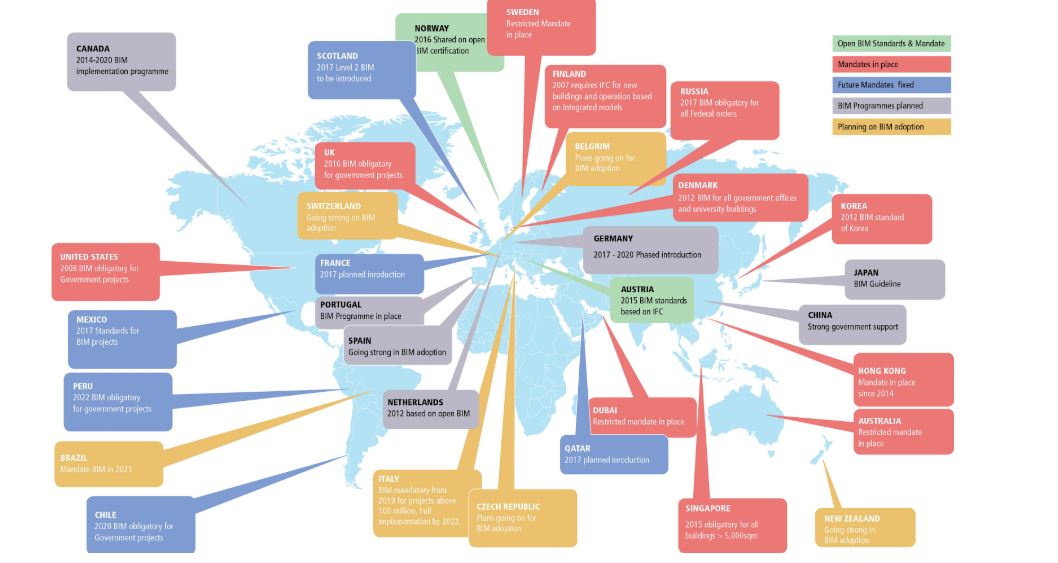More and more governments around the world have started to recognize the efficiencies that can be obtained with the implementation and use of BIM in Infrastructure Projects.
Little Bit of Context: The Current Needs of Our Society
Civil engineering and infrastructure are the logistic, production and mobility basis of our modern society. We can say that the level of modernization and efficiency of a society is proportional to the degree of development of its infrastructures. Global spending on infrastructure has grown to 5.5 trillion dollars annually in 2016. And it will grow up to 9 trillion dollars per year until 2025, a figure more than double of the $4 trillion annual investment recorded in 2012 (Dodge Analytics).
On the other hand, most of the 31 Latin American countries will increase their investments in infrastructure by 250% in order to meet the needs of their growing population (CG / LA 2018 Data model for Infrastructure). In addition, it is forecast that the civil engineering profession will grow an essential 8% between 2016 and 2024 worldwide (US Bureau of Labor Statistics).
Global commitment to the implementation of the BIM methodology
Governments around the world have started to recognize the efficiencies that the implementation and use of
BIM can bring to the table, and there are already many countries where the use of BIM is already a mandatory requirement.
Since the end of last year, the Spanish government insists on the use of BIM in public building projects and as of July 29, 2019, the same will apply for the infrastructure projects. This policy is in line with the road that the EU has taken towards a common aligned European approach that will make possible the development of a world-class digital construction sector.
In South America, there are several future mandates on the horizon. In Chile, by 2020, BIM will be mandatory for all public and private projects. In Peru, by 2022, it will be mandatory for public projects. Mexico approved its BIM standards in 2017.

BIM Tools, a Need and an Obligation
On the road to modernization for greater productivity that has gained ground in the construction sector,
the digitalization of the whole planning process of infrastructure since its early stages is undoubtedly a key aspect. It is essential to
take advantage of and manage the information coming from the GIS (Geographic Information Systems) that the different public organisms of many states have been working and evolving during the last decade.
The information used in this initial stage of planning evolves in various steps. In the design part, you will obtain
virtual models that are constructible, and then these models will serve as the prospective database to carry out the
maintenance of the asset in a more efficient way.
There is a
broad ecosystem of tools and solutions offered by different IT developers: GIS tools, planning tools, plotting tools, structure modeling tools, budget integration tools, coordination tools, quality control and safety and health tools, virtual planning tools, and tools for maintenance and operation.
It is important to
know those tools and learn how they all work to have a broad and global overview of everything that will affect the daily work of a civil engineer. The student will experience the application and capabilities of BIM methodology, its strengths and weaknesses, and above all, how these tools exchange information between them. Knowledge of these tools will allow establishing the points of comparison between them, which is necessary
to evaluate and decide their suitability in public works projects.
Each infrastructure project will require an optimal BIM solution, a global recipe on which tools to use at each stage, and how to manage the information that passes between them so that they can generate the maximum added value for the project and its implementation.
The concept of "Industry 4.0" has reached the construction sector. In this case, industrialization, logging and systematization of tasks mean greater efficiency. The bases of Lean Construction entail the correct development of a virtual model that can be transported on site of the project in different ways: use of numerical control machines that have received their original data of BIM models for the direct cutting of steel profiles, generation of reinforcement of structures, use of earthmoving machinery that automatically receives data from the BIM model through GPS, use of augmented reality to check the correct execution of work and usage of drones, etc.
We must know how to apply the functionalities of BIM in our projects and align them with the objectives and KPI of the public and private client that hires us.
Collaboration Processes
In an increasingly global world, offshored and characterized by multidisciplinary teams, the management o
f the communication between the different members of the team must be much more integral and immersive.
The decisions that different people in charge and members of the project-construction-maintenance team have to make based on a virtual model
require different mechanisms of file sharing and information management than the current ones can offer.
One of the main differences that the use of BIM makes can be observed in the construction phase: we don't take the most important decisions of the project on site anymore as, in reality,
everything major has already been decided in the project phase on a consensual basis. These decisions will be made based on a virtual model and, for this reason, the communication between the different agents of the project is a crucial aspect. The communication via e-mail does not allow the potential of the BIM methodology to be exploited to the maximum, so it must necessarily evolve towards the use of collaborative frameworks and different platforms to share and follow these data.
The new collaboration and communication tools allow the different members of a project team to integrate, streamline and channel information much better.
The learning and simulation of this type of communication and collaboration tools is a fundamental pillar to build the foundations of the BIM methodology.
Training that Responds to the Needs of the Industry
As the construction sector is evolving rapidly hand in hand with the new technologies, it is important for the professionals to keep themselves updated. That’s why the Zigurat Global Institute of Technology has taken on the task to respond to the industries’ need for professionals capable of leading the implementation of BIM methodology in civil infrastructure projects.
The aim has always been to create a learning environment that is most similar to a real multidisciplinary working environment. For this purpose, the focus is on collaborative practices and the new possibilities offered by the current information and communication technologies that all professionals can incorporate into their work dynamics. We have tried to find a practical approach to each of the subjects and classes that constitute the syllabus, avoiding the mere learning of computer tools.
For this, the creation and use of new workflows will be fundamental throughout the course of the programs. At the beginning of the master, these flows will be shown by our teaching team with the hope that soon our students can exercise autonomously creating their own.
Our desire is to transmit to the students the "philosophy" of BIM, and encourage them to become professional colleagues within the field of BIM Management and the BIM consultancy. With sufficient resources and the necessary weapons to solve any problem in the planning, project, execution and management phases of infrastructure, the students will be able to fully embrace the paradigm shift in the construction sector.

